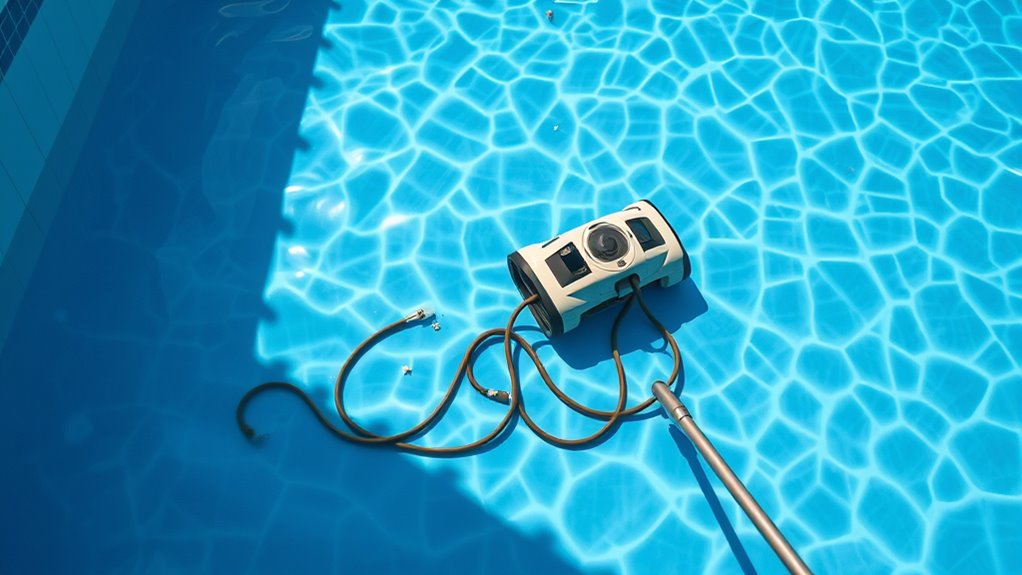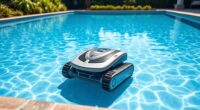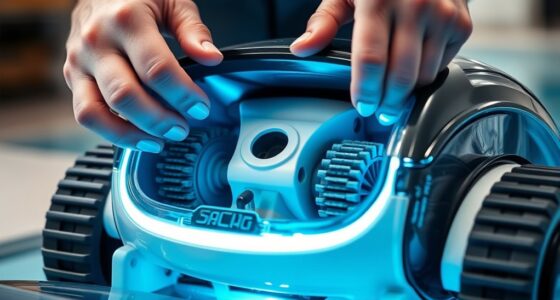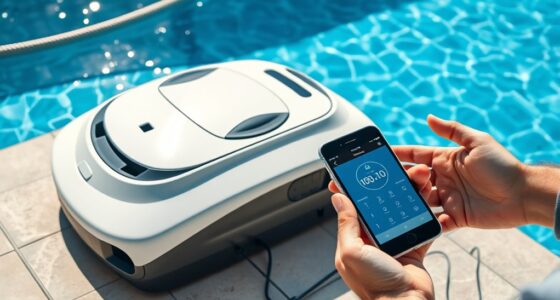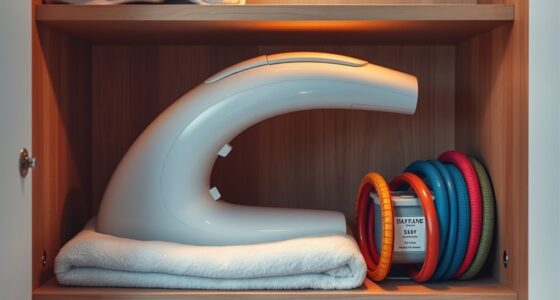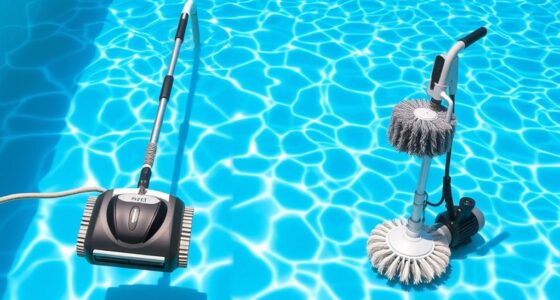One common mistake is not checking and cleaning the skimmer and pump baskets regularly, which leads to clogs and reduced suction. Improperly positioning the cleaner in the pool, especially in debris-heavy areas, can cause missed spots and strain the device. Failing to secure hoses tightly or using an incompatible cleaner size/type can cause disconnections or ineffective cleaning. Overlooking routine maintenance, like filter checks and removing debris, can also harm performance. Keep these tips in mind to avoid common pitfalls and guarantee ideal cleaning.
Key Takeaways
- Failing to remove large debris before cleaning can clog the system and reduce efficiency.
- Ignoring regular filter and basket maintenance leads to decreased suction and equipment damage.
- Not securing hoses properly can cause disconnections and loss of suction during operation.
- Using an incompatible cleaner for your pool’s debris type or surface can result in poor cleaning and damage.
- Neglecting water level adjustments and obstructions hampers suction and movement, reducing cleaning effectiveness.
Failing to Check and Clean the Skimmer and Pump Baskets
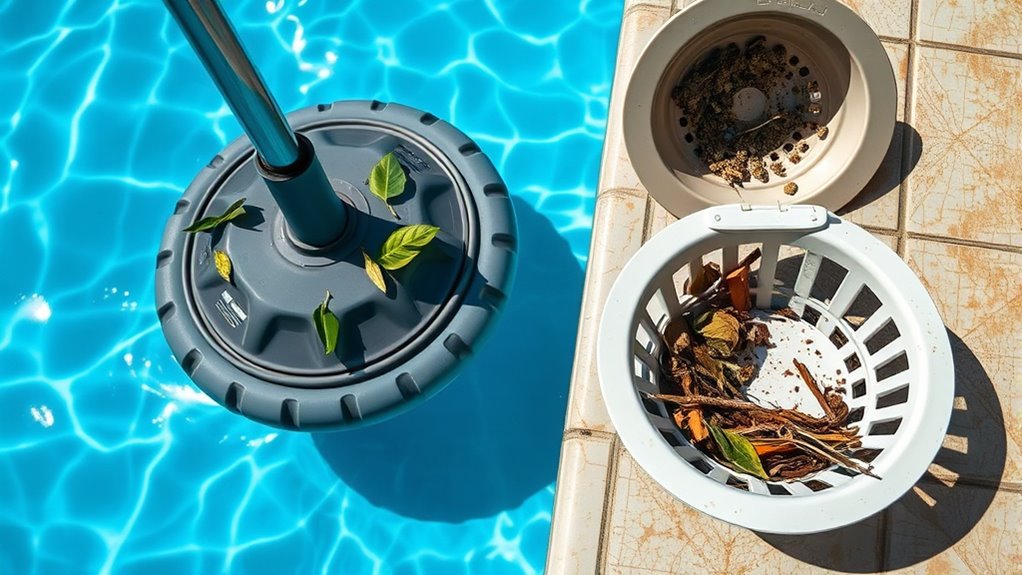
If you neglect to regularly check and clean the skimmer and pump baskets, your suction pool cleaner can quickly lose efficiency. When these baskets are clogged, debris builds up, reducing water flow and impairing the cleaner’s performance. Maintaining proper pool chemical balance is also vital, as imbalanced chemicals can cause algae or mineral buildup that blocks filters. Additionally, clean pool lighting ensures you can spot debris or issues early, preventing clogs from worsening. A dirty skimmer basket forces the pump to work harder, which can strain the entire system and decrease cleaning effectiveness. Regularly emptying these baskets and monitoring pool chemistry keeps water flowing smoothly, ensuring your suction cleaner operates ideally and your pool stays clean and inviting. Proper lighting setup in your pool’s lighting setup can also improve visibility, making it easier to identify and address potential issues promptly.
Incorrectly Positioning the Cleaner in the Pool
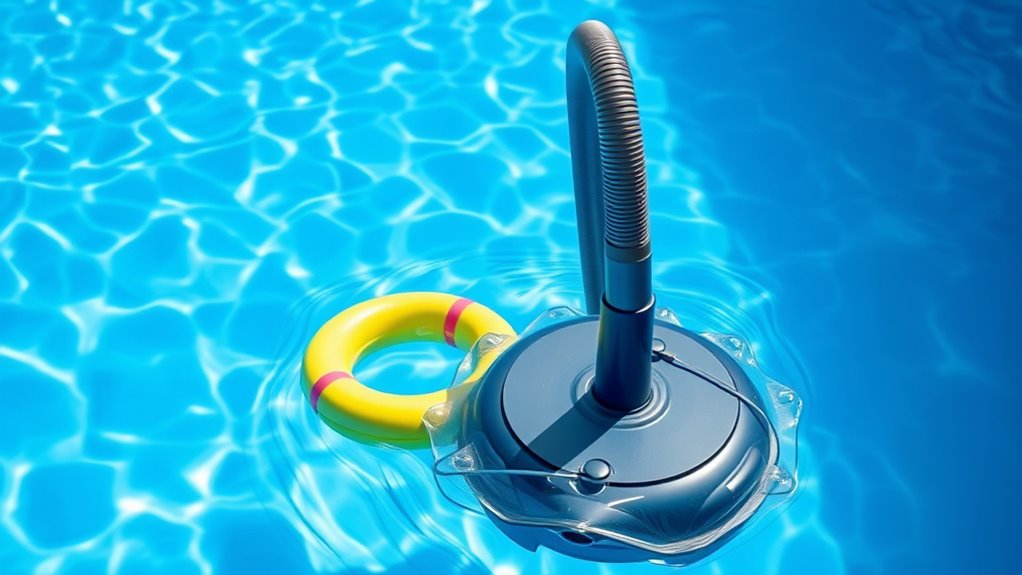
Proper placement of your suction pool cleaner is essential for effective cleaning. If you position it incorrectly, you may miss spots or strain your pool’s components. Make sure the cleaner is directed toward areas with more debris, like corners or steps, but avoid placing it in one spot for too long. Keep in mind that poor positioning can disrupt your pool chemistry, leading to uneven chemical distribution and increased manual cleaning. Also, don’t forget to check for obstructions that might block suction or hinder movement. Properly positioning the cleaner helps it work efficiently, reducing the need for constant oversight. Additionally, maintaining optimal equipment setup is crucial for extending the lifespan of your pool’s components and ensuring consistent cleaning performance. When the cleaner is correctly positioned, it can maximize cleaning efficiency and reduce the likelihood of tangling or damage. To achieve this, regularly inspect the hoses and brushes for wear and proper connection, which can influence overall cleaning effectiveness. Ensuring proper positioning techniques are followed can prevent many common issues associated with suction pool cleaners. Proper positioning also ensures that the automation technology used in modern cleaners operates smoothly, avoiding unnecessary malfunctions.
Not Securing the Hoses Properly
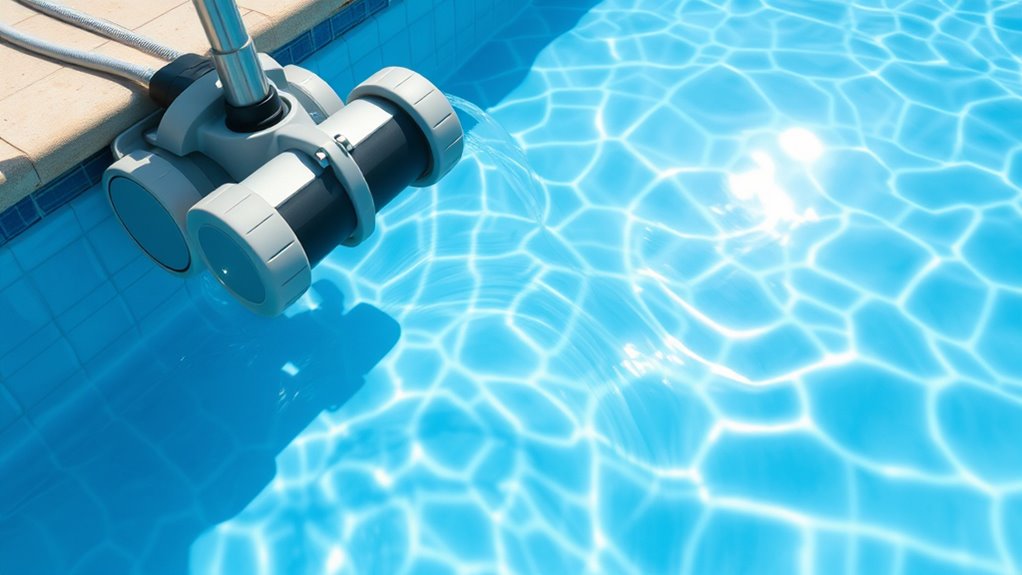
Failing to secure the hoses properly can cause your suction pool cleaner to lose suction, reduce its effectiveness, and even damage the equipment. If the hose connections aren’t tight or secure, air can enter the system, decreasing suction power. Always double-check that you’ve secured hoses firmly at each connection point before starting your cleaner. Loose hoses can slip or disconnect during operation, leading to inefficient cleaning or the cleaner getting stuck. Properly securing hoses ensures an airtight seal, maintaining ideal suction and smooth movement across the pool floor. Take the time to inspect all hose connections before use, and tighten any loose fittings. Additionally, reviewing cookie categories and managing user consent can improve your overall experience with pool maintenance tools online. Doing so prevents unnecessary setbacks, keeps your cleaner working effectively, and prolongs the lifespan of your equipment. Ensuring all components are compatible and correctly assembled is also crucial for optimal pool cleaning performance. Regularly inspecting the hoses and fittings can also help identify potential issues early, ensuring your cleaner functions at its best. Using high-quality connectors and fittings reduces the likelihood of leaks and disconnections during operation, further improving efficiency.
Using the Wrong Size or Type of Cleaner for Your Pool

Choosing the right cleaner depends on your pool’s size and debris type. If you select a model that’s too small or too powerful, it won’t clean efficiently. Make sure to match the cleaner to your pool and debris for the best results.
Match Pool Size
Using the wrong size or type of suction pool cleaner can make it difficult to keep your pool clean and may even cause damage. If your cleaner is too small for your pool size, it won’t pick up debris efficiently, leading to poor water quality and imbalanced pool chemistry. Conversely, a cleaner that’s too large can strain your filtration system and put unnecessary stress on pool components. To guarantee safety precautions are met, choose a cleaner designed for your pool’s dimensions. Proper matching helps maintain consistent cleaning performance and reduces the risk of equipment failure. Always check the manufacturer’s recommendations, and avoid using a cleaner intended for different pool sizes. Correctly matching your pool size helps keep your pool safe, clean, and well-maintained.
Select Compatible Model
Selecting the right model of suction pool cleaner is essential to guarantee effective and efficient cleaning. You need a cleaner compatible with your pool’s size and type to avoid frustration and missed spots. Make sure the cleaner suits your pool’s dimensions and shape, especially if you have an irregular or large outdoor pool cover. Consider your pool’s chemical balance, as high or low chemical levels can affect cleaner performance. Using an incompatible model may cause it to get stuck or work inefficiently, wasting energy and time. Always check manufacturer recommendations for your specific pool type, and choose a model designed for your pool’s features. Properly matching the cleaner to your pool ensures thorough cleaning, preserves your equipment, and extends its lifespan. Additionally, understanding AI’s role in automating pool maintenance can help you select smarter cleaning solutions and optimize your pool care routine. For optimal performance, also take into account the proper maintenance of filters and brushes, which can significantly impact cleaning efficiency and the longevity of your equipment.
Consider Debris Type
Understanding the types and sizes of debris in your pool is essential to guarantee your cleaner works effectively. Different debris types, like leaves, dirt, or small particles, require specific suction power and cleaner features. For instance, a cleaner designed for fine debris may struggle with larger leaves, while one meant for large debris could clog easily with small dirt particles. Additionally, consider your pool surface—whether it’s vinyl, concrete, or fiberglass—as some cleaners are better suited for certain surfaces. Using the wrong type or size of cleaner for your debris and pool surface can lead to inefficient cleaning or damage. Properly identifying debris characteristics and matching them with a compatible cleaner helps improve cleaning efficiency and extend the lifespan of your equipment. Selecting the right cleaner also involves understanding clogging risks, which can be minimized by choosing a model with appropriate filtration capabilities. Regular maintenance and cleaning of the cleaner itself can also prevent filter blockages and maintain optimal suction performance. Recognizing the different debris types present in your pool can help you choose a cleaner that handles each effectively. Being aware of pool size and shape can additionally influence the performance of certain cleaners and is important for optimal operation. Match your debris type with a compatible cleaner to optimize performance and prolong its lifespan. This ensures your pool stays clean without unnecessary hassle or repairs.
Overlooking Regular Inspection and Maintenance of the Cleaner

Neglecting regular inspection and maintenance can lead to poor cleaning performance and costly repairs. Make it a habit to schedule routine checks, clean the filter often, and look for any signs of damage. Staying on top of these tasks guarantees your cleaner works efficiently and lasts longer. Additionally, understanding filter replacement schedules and adhering to them is crucial for maintaining optimal air quality and device longevity. Incorporating efficient operation techniques such as proper placement and usage can further enhance the cleaner’s effectiveness and energy savings. Regularly updating your knowledge on lifestyle best practices can also contribute to a more productive and stress-free cleaning routine. Being aware of survivalist maintenance practices can help ensure your equipment remains reliable in emergency situations. To ensure consistent results, consider implementing a maintenance checklist to track your cleaning and inspection activities effectively.
Schedule Routine Checks
Regularly scheduling routine checks is essential to keep your suction pool cleaner functioning effectively. By inspecting your equipment frequently, you can catch issues early before they become costly repairs. Guarantee the pool’s chemical balance is maintained, as imbalances can affect the cleaner’s performance and longevity. Additionally, check that the pool heater is properly maintained, since inconsistent heating can cause debris buildup or damage the cleaner’s components. Inspect hoses and connections for leaks or blockages, and verify that the cleaner moves smoothly across the pool surface. Regular maintenance helps prevent breakdowns and extends the life of your cleaner, saving you time and money. Conducting filter replacement inspections can also help identify potential engine or performance issues that may impact your pool equipment. Making routine checks part of your pool care routine ensures your suction pool cleaner works efficiently and keeps your pool sparkling.
Clean Filter Regularly
Cleaning the filter frequently is essential for maintaining your suction pool cleaner’s efficiency. Proper filter maintenance ensures debris removal is effective, preventing clogs that can hinder performance. Neglecting this step can cause the cleaner to work harder and reduce its lifespan. Make it a habit to check and clean the filter regularly, especially after heavy debris accumulation. During filter cleaning, inspect for tears or damage that could compromise its function. To keep your filter in top shape, consider these tips:
- Remove debris promptly to prevent buildup
- Rinse the filter thoroughly with clean water
- Replace damaged filters immediately
Consistent filter maintenance keeps your cleaner running smoothly and extends its durability, making your pool cleaning more effective and less prone to issues.
Inspect for Damage
Inspecting your suction pool cleaner for damage is a critical step that many overlook, but it can prevent major breakdowns. Regular inspections help you catch cracks, leaks, or worn parts early, saving you costly repairs. Confirm the pool’s chemical balance is proper, as imbalanced water can cause corrosion or deterioration of the cleaner’s components. Proper operator training is essential; understanding how to examine hoses, brushes, and seals keeps you alert to issues. Don’t forget to check for tangled or damaged parts that could reduce suction efficiency. If you spot any damage, address it promptly before it worsens. By combining careful inspection with attention to pool chemistry and operator training, you’ll keep your cleaner running smoothly and extend its lifespan.
Ignoring Pool Water Levels During Cleaning
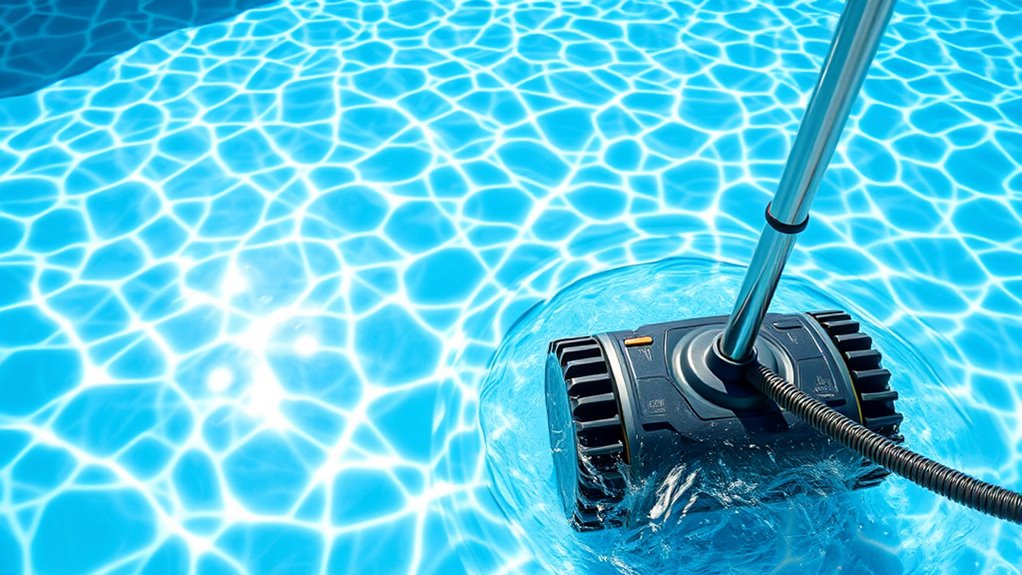
If you neglect to monitor your pool’s water levels during cleaning, you risk disrupting the suction process and potentially damaging your cleaner. Low water levels can cause the cleaner to lose suction, while high levels may lead to inefficient cleaning. Additionally, improper water levels can interfere with maintaining proper pool chemistry, affecting clarity and safety. To avoid these issues:
- Regularly check water levels and top off if needed
- Ensure water is at the recommended level, usually midway up the skimmer opening
- Follow safety precautions to prevent equipment damage or injury
Maintaining correct water levels ensures ideal suction, preserves your pool’s chemistry, and prolongs your cleaner’s lifespan. Staying vigilant during cleaning helps prevent costly repairs and keeps your pool safe and inviting.
Neglecting to Remove Obstructions and Debris From the Pool

Neglecting to remove obstructions and debris from your pool can substantially hinder your cleaner’s performance. When debris like leaves, twigs, or dirt accumulate, they can clog the suction and reduce cleaning efficiency. Additionally, clutter around the pool, such as pool toys or furniture, can block the cleaner’s path. Regularly check and maintain your pool’s chemical balance to prevent algae and grime buildup that could worsen debris collection. Also, ensure your pool lighting options are clear of obstructions; poor lighting can hide debris or damage the cleaner’s sensors. By keeping the pool free of obstructions and debris, you help your suction cleaner work more effectively, saving time and energy while maintaining a cleaner, healthier pool environment.
Running the Cleaner for Too Long or Too Short a Duration
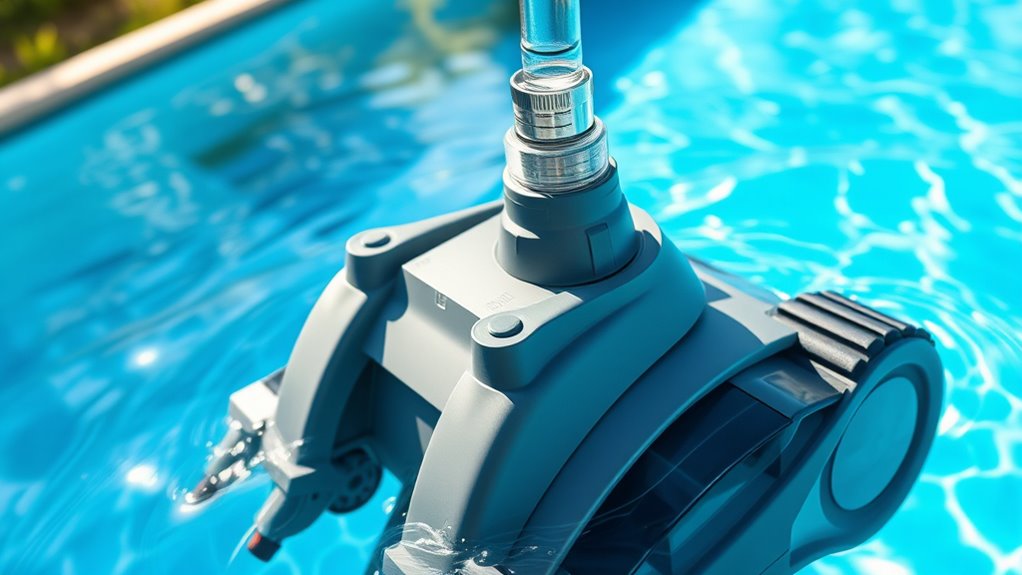
Running your suction pool cleaner for the right amount of time is essential for effective cleaning and avoiding unnecessary wear. If you run it too long, the suction power may decline, and the motor could overheat, reducing longevity. Conversely, too short a run might leave debris behind, compromising your cleaning schedule. To optimize performance:
- Adjust run times based on pool size and debris level
- Monitor suction power to ensure consistent cleaning
- Follow a regular cleaning schedule to prevent buildup
Balancing these factors helps maintain efficiency, prolongs the cleaner’s lifespan, and ensures your pool stays crystal clear. Proper timing reduces strain on the device and guarantees it works at peak suction power, delivering thorough cleaning without unnecessary strain.
Forgetting to Adjust or Replace the Filter as Needed
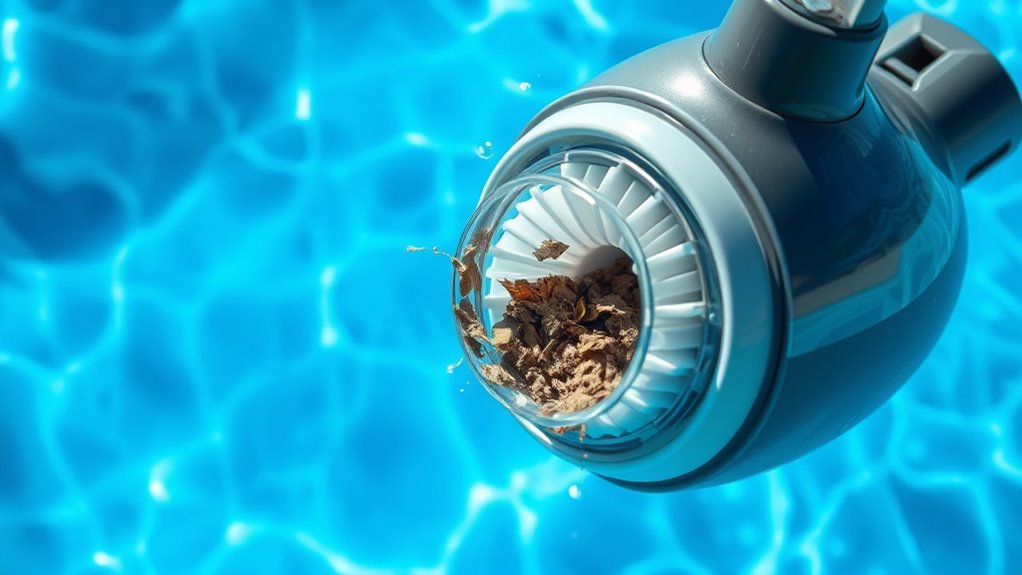
Make sure to regularly check your pool cleaner’s filter to keep it running efficiently. If it’s dirty or clogged, replace it promptly to prevent reduced suction and performance issues. Monitoring the filter helps you catch problems early and keeps your pool cleaner working its best.
Regular Filter Checks
Regular filter checks are essential to keep your suction pool cleaner functioning efficiently. Over time, debris can clog the filter, reducing suction power and hindering debris management. By routinely inspecting and adjusting the filter, you guarantee optimal performance. Neglecting this step can lead to decreased cleaning efficiency and potential damage. During your checks, focus on:
- Removing debris buildup to prevent blockages
- Inspecting filter condition for wear or tears
- Replacing filters when they become overly dirty or damaged
Consistent filter maintenance keeps your cleaner running smoothly and prolongs its lifespan. Remember, a clean filter helps maintain proper water flow and improves debris removal, making your pool cleaning process hassle-free. Don’t overlook this simple yet crucial step in your pool maintenance routine.
Replace When Dirty
If you don’t replace or adjust your filter when it becomes dirty, your suction pool cleaner’s performance will suffer. A clogged filter restricts water flow, reducing cleaning efficiency and putting extra strain on your pump. After seasonal pool cover removal, debris increases, making it essential to check and replace filters promptly. Keep in mind that dirty filters can also interfere with pool chemical balancing, as poor water circulation affects chemical distribution. Regularly inspect your filter and swap it out when necessary to maintain peak suction and filtration. Don’t forget, a clean filter helps ensure your pool stays clear and safe. Staying on top of filter maintenance prevents unnecessary wear on your cleaner and keeps your pool in prime condition throughout the season.
Monitor for Clogs
When inspecting your pool filter, keep a close eye out for signs of clogs or reduced flow. A clogged filter can hinder your suction pool cleaner’s effectiveness and cause strain on the system. Regularly check the filter and replace or adjust it as needed. Remember, debris buildup from pool chemicals or algae can quickly clog filters. Also, ensure that pool lighting isn’t obstructed by debris, which can indicate underlying flow issues.
- Watch for decreased suction power or inconsistent cleaning patterns
- Clear out debris and rinse filters frequently
- Adjust or replace filters promptly to maintain ideal flow and prevent damage
Monitoring for clogs helps ensure your cleaner works efficiently and extends its lifespan. Staying vigilant keeps your pool clean, safe, and ready for swimming.
Using the Cleaner on a Dirty or Cluttered Pool Floor
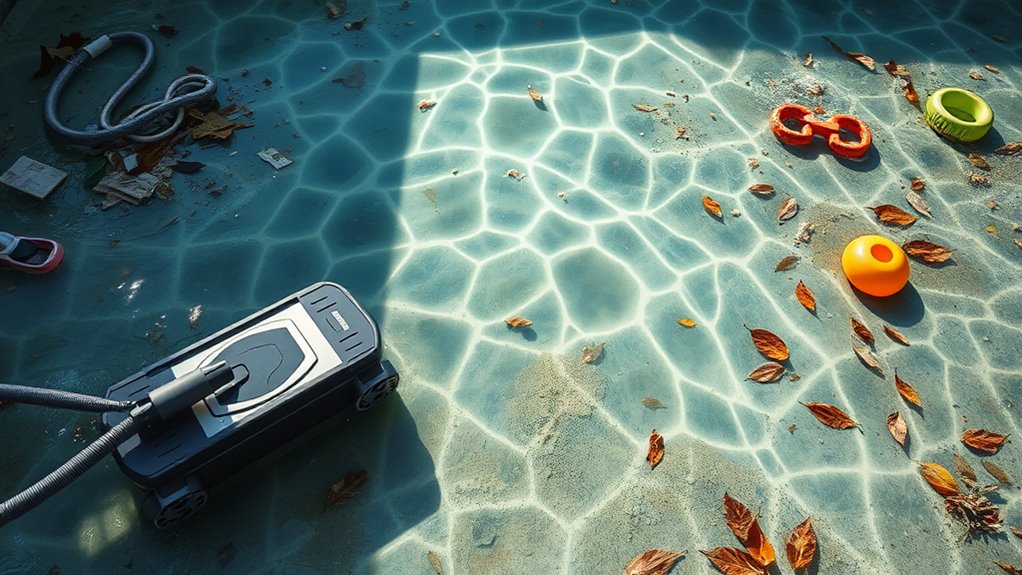
Ever wondered why your suction pool cleaner struggles to pick up debris on a cluttered pool floor? The problem often lies in a dirty or cluttered surface that blocks the cleaner’s suction. Before use, guarantee your pool is clean and free of large debris. Poor pool chemistry or low water temperature can also reduce suction efficiency, making it harder for the cleaner to operate effectively.
| Issue | Effect | Solution |
|---|---|---|
| Cluttered floor | Obstructs suction | Clear large debris before cleaning |
| Low water temperature | Slows motor | Warm water helps performance |
| Imbalanced pool chemistry | Affects debris breakdown | Balance chemicals regularly |
Proper preparation ensures your cleaner works smoothly and efficiently.
Frequently Asked Questions
How Often Should I Replace the Suction Pool Cleaner’S Filters?
You should replace your suction pool cleaner’s filters based on your cleaning schedule and the level of debris in your pool. Generally, check the filters weekly and do a thorough cleaning. If they look damaged or aren’t functioning well after cleaning, it’s time for filter replacement. Maintaining a regular cleaning schedule not only extends filter life but also ensures your pool stays clean and the cleaner works efficiently.
Can a Suction Cleaner Damage Delicate Pool Fixtures?
You might wonder if a suction cleaner can harm delicate pool fixtures or damage delicate equipment safety. The truth is, if you don’t set it up properly, it can cause pool fixture damage, especially with sensitive equipment. To prevent this, always check for proper suction levels, avoid running the cleaner over fragile fixtures, and regularly inspect connections. Proper usage safeguards your pool fixtures and ensures safe, effective cleaning without risking damage.
What Safety Precautions Are Recommended When Operating the Cleaner?
When operating your suction pool cleaner, you should prioritize safety to prevent accidents. Always follow electrical safety guidelines by ensuring the power source is properly grounded and avoid using extension cords. Handle the cleaner carefully, keeping it away from pool edges and delicate fixtures. Proper handling also means checking hoses and connections regularly. By taking these precautions, you reduce risks and keep both yourself and your pool safe during cleaning.
How Do I Troubleshoot if the Cleaner Is Not Moving Properly?
Ever wonder why your pool cleaner isn’t moving properly? Start with pool cleaner diagnostics by checking the hose for kinks or blockages—they often cause troubleshooting suction issues. make certain the skimmer and pump baskets are clean, and the float valve is properly positioned. If problems persist, inspect the cleaner’s wheels and brushes for debris or damage. Regular maintenance helps prevent these issues, keeping your cleaner running smoothly and efficiently.
Is It Necessary to Remove Algae Before Using the Cleaner?
You should remove algae before using your suction pool cleaner to make sure it works efficiently. Algae removal helps prevent clogs and improves cleaning performance, especially on the pool surface. If algae is present, the cleaner might struggle to pick up debris or get stuck. By cleaning the algae first, you allow your cleaner to operate smoothly, keeping your pool sparkling clean and reducing wear on the equipment.
Conclusion
To keep your suction pool cleaner working efficiently, avoid these common mistakes. Regularly check skimmer and pump baskets, properly position the cleaner, and make certain hoses are secure. Did you know that neglecting maintenance can reduce your cleaner’s lifespan by up to 30%? By staying attentive and following these tips, you’ll keep your pool sparkling and save money on repairs. A little effort goes a long way in maintaining a clean, healthy swimming environment.
